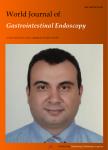Outcome in obscure gastrointestinal bleeding after capsule endoscopy
Outcome in obscure gastrointestinal bleeding after capsule endoscopy作者机构:Department of GastroenterologyHospital del Mar Research InstitutePompeu Fabra University Endoscopic UnitGastroenterology DepartmentICMDiM. Hospital Clínic
出 版 物:《World Journal of Gastrointestinal Endoscopy》 (世界胃肠内镜杂志(英文版)(电子版))
年 卷 期:2013年第5卷第11期
页 面:551-558页
学科分类:1002[医学-临床医学] 100201[医学-内科学(含:心血管病、血液病、呼吸系病、消化系病、内分泌与代谢病、肾病、风湿病、传染病)] 10[医学]
主 题:Capsule endoscopy Obscure gastrointestinal bleeding Small bowel Angiodysplasia Enteroscopy
摘 要:AIM: To investigate the clinical impact of capsule endoscopy(CE) after an obscure gastrointestinal bleeding(OGIB) episode, focusing on diagnostic work-up, followup and predictive factors of rebleeding. METHODS: Patients who were referred to Hospital del Mar(Barcelona, Spain) between 2007 and 2009 for OGIB who underwent a CE were retrospectively analyzed. Demographic data, current treatment with non-steroid antiinflammtory drugs or anticoagulant drugs, hemoglobin levels, transfusion requirements, previous diagnostic tests for the bleeding episode, as well as CE findings(significant or non-significant), work-up and patient out-comes were analyzed from electronic charts. Variables were compared by χ 2 analysis and Student t test. Risk factors of rebleeding were assessed by Log-rank test, Kaplan-Meier curves and Cox regression model. RESULTS: There were 105 patients [45.7% women, median age of 72 years old(interquartile range 56-79)] and a median follow-up of 326 d(interquartile range 123-641) included in this study. The overall diagnostic yield of CE was 58.1%(55.2% and 63.2%, for patients with occult OGIB and overt OGIB, respectively). In 73 patients(69.5%), OGIB was resolved. Multivariate analysis showed that hemoglobin levels lower than 8 g/dL at diagnosis [hazard ratios(HR) = 2.7, 95%CI: 1.9-6.3], patients aged 70 years and above(HR = 2.1, 95%CI: 1.2-6.1) and significant findings in CE(HR = 2.4, 95%CI: 1.1-5.8) were independent predictors of rebleeding. CONCLUSION: One third of the patients presented with rebleeding after CE; risk factors were hemoglobin levels 8 g/dL, age ≥ 70 years or the presence of significant lesions.



